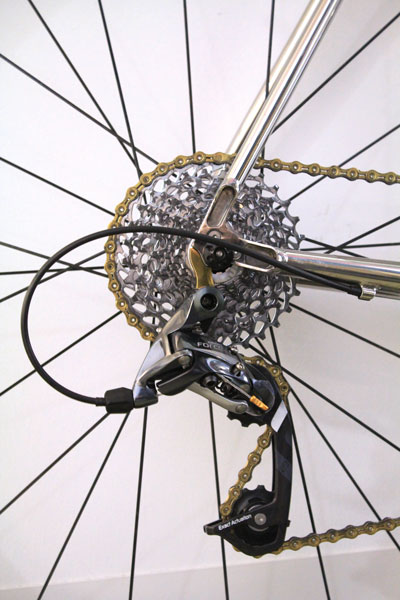A smart and beautifully-executed wide-range gearing solution for the road: Iain Treloar reports on testing.

Rating 90%
Function 38/40
Quality 38/40
Price 7/10
Appearance 7/10
Derailleur from $94.95 (Apex), $174.95 as tested (Force 22); cassette from $71.95 (Apex), $134.95 as tested (Force 22)
At first glance this might seem an odd review item—it’s a derailleur, paired with a cassette. However, the biggest secret of SRAM’s WiFLi system isn’t what it weighs or looks like, but what it allows you to accomplish.
For a long time, road riders were stuck with gearing designed for speed on the flat; on really steep climbs the going got pretty tough. Then, higher cadences started to became more common, and elite riders started experimenting with compact and triple cranksets to allow them to maintain that high cadence on extreme gradients.
SRAM’s WiFLi (Wider range than a triple crankset, with a Faster shift and Lighter overall weight) set-up is a rare example of product trickle-up, introduced in the brand’s lower-end road models. It’s now available across the board—from Apex all the way up to Red 22.
The WiFLi system’s shifting will depend on the existing level of your drivetrain, but certainly isn’t any slower or clunkier than a conventional derailleur. In my case, running the excellent Force 22 groupset, it performed admirably, maintaining the sharp, crisp changes that SRAM have made their calling card.
To accommodate a large ratio cassette (tested here in 11–32t), a redesigned rear derailleur is required, with a longer cage to allow it to shift up to that whopping 32t cog – a conventional road derailleur will only allow you to go up to a 28t on the rear. It’s not a particularly fashionable choice, looking like a bastardised mountain bike derailleur and cassette, but the difference those four extra teeth makes is enormous. My testing for this set-up was a baptism of fire at the SCODY 3 Peaks Challenge, which concludes with the awful climb up the back of Falls Creek—10km at 10% and ramps exceeding 13%, with 200km already in the legs. I have never been happier to have lower gears to shift into, or more pathetically grateful for any bike tech innovation. Largely thanks to WiFLi, I was able to pedal up the climb in relative comfort, surrounded by walking, cramping fellow masochists.
Cost will vary depending on what model WiFLi set-up you go for, and the change will necessitate a new chain as well as the cassette and derailleur. It may not be cheap, but if you’ve got some tough climbing ahead of you, the financial hit will be quickly forgotten in the euphoria of cresting a previously insurmountable climb.
More info monzaimports.com.au/bicycle
Ride On content is editorially independent, but is supported financially by members of Bicycle Network. If you enjoy our articles and want to support the future publication of high-quality content, please consider helping out by becoming a member.
